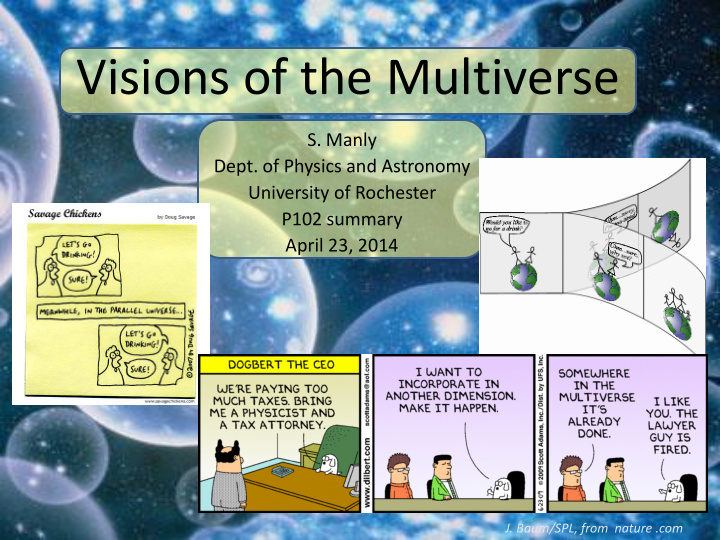



Visions of the Multiverse S. Manly Dept. of Physics and Astronomy University of Rochester P102 summary April 23, 2014 J. Baum/SPL, from nature .com
“Multiple universe” … an oxymoron? Before the many, define the one … What is “the universe”? Hubble deep field photo 23 day exposure Over 5500 galaxies
The universe (my working definition): Everything that exists or could ever exist, in principle, in our experience. (“Our experience” includes things inferred by instrumentation.) Everything to which we are causally connected, now or in the future.
Mathematical
Mathematical
http://www.hps.cam.ac.uk/starry/copercosmol.html Cosmetology CMB, from ESA’s Planck mission website The Christian Aristotelian cosmos, engraving from Peter Apian's Cosmographia.
Vesto Slipher (1875-1969) Lowell Observatory discovers a strange thing in 1912 … Most nearby galaxies are moving away from us Made use of the Doppler shift in atomic spectra
Edwin Hubble (1889-1953) and Milton Humason (1891-1972) at Mount Wilson Observatory combine Hubble’s distance measurements (Cephied variable stars) with Slipher’s reshift information and discover … Hubble Galaxies that are further away are moving away from us faster Hubble’s Law V=Hd Humason (from AIP)
Welcome to the “expanding universe”!! extrapolate back in time find the age of the universe 13.7 billion years. Type Ia SNe from Riess, Press and Kirshner (1996) Light travels 1 Mpc in 3 million years
Type 1A supernovas – Use as “standard candle” to gauge distance to distant objects Energy produced in a short period is roughly that produced by the sun (at current energy output) in about 10 billion years.
Spectral lines (atomic absorption) can provide classification information for the type of supernova and allow for recession velocity determination using the relativistic Doppler effect (frequency shift of the light)
Beasts dwell here TIME
From http://ned.ipac.caltech.edu/level5/Sept02/Kinney/Kinney3.html
Penzias and Wilson and the antenna used to first detect the CMB From http://aether.lbl.gov/cmb.html From http://www.astro.ucla.edu/~wright/CMB.html
From http://aether.lbl.gov/cmb.html
Big bang nucleosynthesis
Origin of elements
Expansion of space Cosmic microwave background Penzias and Wilson, 1964 Nucleosynthesis The big bang HAD to happen
Flatness problem The hot big bang? What utter nonsense! From J.M. Overduin & P.S. Wesson, Dark Sky, Dark Matter (Institute of Physics Press, 2003)] Magnetic monopole problem Singularity problem Large scale structure problem Horizon problem
Geometry of the universe is ~ flat http://www.youtube.com/watch?v=x8pupNMn5nI
~1979 Guth Linde Albrecht Steinhardt
Flatness problem The hot big bang? What utter nonsense! From J.M. Overduin & P.S. Wesson, Dark Sky, Dark Matter (Institute of Physics Press, 2003)] Magnetic monopole problem Singularity problem Large scale structure problem Horizon problem
Cold dark matter Fritz Zwicky Bullet cluster Vera Rubin (published with Kent Ford)
Dark energy 2011 Nobel prize: Permutter, Schmidt, Reiss
“The total energy – matter plus gravitational – remains constant and very small, and could even be exactly zero. … If inflation is right, everything can be created from nothing, or at least from very little. If inflation is right, the universe can properly be called the ultimate free lunch.” - Alan Guth
What drives inflation? What is dark energy? A non- string theorists view of a string theorist’s view of inflation/dark energy A viable string theory of reality (if such exists) will have to be in 10 dimensions Compactification Fig from Bousso and Polchinski, The String Theory Landscape, Scientific American, 2004. Figs from http://www.learner.org/courses/physics/unit/text.html?unit=4&secNum=4
Hot big bang + CDM + DE + inflation Is this crazy? Clues from the CMB COBE WMAP Planck CMB, from ESA’s Planck mission website
WMAP CMB angular feature size power spectrum – acoustics in the early universe! The characteristics of sound waves depend on the medium! This data is sensitive to amount of Normal matter, dark matter, dark energy and inflationary model of the early universe
From the Planck collaboration
2007
Recent result reported by the BICEP2 collaboration
Recommend
More recommend